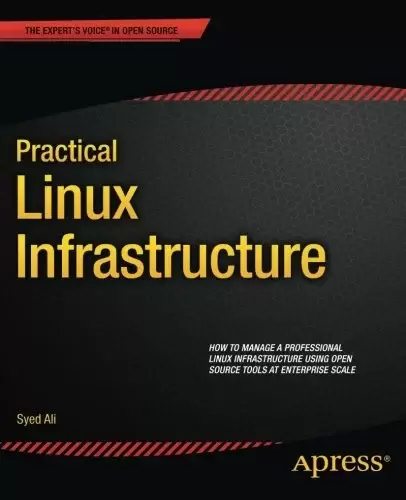
Book Description
Practical Linux Infrastructure teaches you how to use the best open source tools to build a new Linux infrastructure, or alter an existing infrastructure, to ensure it stands up to enterprise-level needs. Each chapter covers a key area of implementation, with clear examples and step-by-step instructions.
Using this book, you’ll understand why scale matters, and what considerations you need to make. You’ll see how to switch to using Google Cloud Platform for your hosted solution, how to use KVM for your virtualization, how to use Git, Postfix, and MySQL for your version control, email, and database, and how to use Puppet for your configuration management. For enterprise-level fault tolerance you’ll use Apache, and for load balancing and high availability, you’ll use HAProxy and Keepalived. For trend analysis you’ll learn how to use Cacti, and for notification you’ll use Nagios. You’ll also learn how to utilize BIND to implement DNS, how to use DHCP (Dynamic Host Configuration Protocol), and how to setup remote access for your infrastructure using VPN and Iptables. You will finish by looking at the various tools you will need to troubleshoot issues that may occur with your hosted infrastructure. This includes how to use CPU, network, disk and memory management tools such as top, netstat, iostat and vmstat.
Author Syed Ali is a senior site reliability engineering manager, who has extensive experience with virtualization and Linux cloud based infrastructure. His previous experience as an entrepreneur in infrastructure computing offers him deep insight into how a business can leverage the power of Linux to their advantage. He brings his expert knowledge to this book to teach others how to perfect their Linux environments. Become a Linux infrastructure pro with Practical Linux Infrastructure today.
What youll learn
- Learn how to deploy enterprise Linux infrastructure
- Create networks, firewalls, load balancers
- Install Postfix, Cacti, Nagios, Apache, MySQL
- Using Google Cloud Platform (GCP) services
- Trouble shootings tools such as top, tcpdump, iostat, vmstat
- Using iptables to protect your host
- Install a GIT server for source code configuration management
- Use rlog for log collections
Who this book is for
This book is ideal for Linux system administrators who are currently managing small to medium size Linux infrastructure environments and would like to learn how to manage enterprise-level infrastructures. You will be familiar with basic system administration, or site reliability engineering work, but want to learn how to build significant, pro-level Linux infrastructure.
Table of Contents
Chapter 1: Managing Large Scale Infrastructure
Chapter 2: Hosted Cloud Solutions Using Google Cloud Platform
Chapter 3: Virtualization with KVM
Chapter 4: MySQL, Git, Postfix
Chapter 5: Configuration Management with Puppet
Chapter 6: Apache for Enterprise-level Fault Tolerance
Chapter 7: Monitoring with Nagios & Trend Analysis with Cacti
Chapter 8: DNS Using Bind and DHCP
Chapter 9: Log Collection, OpenVPN, Iptables
Chapter 10: Troubleshooting Tools
中文:
书名:实用的Linux基础架构
实用的Linux基础架构 教您如何使用最好的开源工具来构建新的Linux基础设施,或更改现有的基础设施,以确保它能够满足企业级需求。每一章都包括一个关键的实施领域,并有明确的例子和循序渐进的说明。
使用这本书,您将了解为什么规模很重要,以及您需要考虑什么。您将了解如何切换到使用Google Cloud Platform作为托管解决方案,如何使用KVM进行虚拟化,如何使用Git、Postfix和MySQL进行版本控制、电子邮件和数据库,以及如何使用Pupet进行配置管理。对于企业级容错,您将使用Apache,而为了实现负载平衡和高可用性,您将使用HAProxy和Keepalived。对于趋势分析,您将学习如何使用Cacti,而对于通知,您将使用Nagios。您还将学习如何利用BIND来实现DNS、如何使用动态主机配置协议(动态主机配置协议),以及如何使用VPN和IPTABLes为您的基础设施设置远程访问。最后,您将了解各种工具,您将需要这些工具来排除托管基础架构可能出现的问题。这包括如何使用CPU、网络、磁盘和内存管理工具,如top、netstat、iostat和vmstat。
作者Syed Ali是一名高级站点可靠性工程经理,在虚拟化和基于Linux云的基础设施方面拥有丰富的经验。他之前作为基础设施计算企业家的经验让他对企业如何利用Linux的力量为自己带来优势有了深刻的洞察。他将自己的专业知识带到这本书中,教其他人如何完善他们的Linux环境。立即成为Linux基础架构专家,拥有实用的Linux基础架构。
你会学到什么?
- Learn how to deploy enterprise Linux infrastructure
- 创建网络、防火墙、负载平衡器
- 安装Postfix、Cacti、Nagios、Apache、MySQL
- Using Google Cloud Platform (GCP) services
- 故障排除工具,如top、tcpump、iostat、vmstat
- 使用iptable保护您的主机
- 安装Git服务器以进行源代码配置管理
- 使用RLOG进行日志收集
这本书是为谁而写的
本书非常适合目前正在管理中小型Linux基础架构环境并希望了解如何管理企业级基础架构的Linux系统管理员。您将熟悉基本的系统管理或站点可靠性工程工作,但希望了解如何构建重要的专业级Linux基础设施。
目录表
第1章:管理大型基础设施
第2章:使用Google云平台的托管云解决方案
第3章:使用KVM进行虚拟化
Chapter 4: MySQL, Git, Postfix
第5章:使用PUPJET进行配置管理
第6章:用于企业级容错的APACHE
第7章:使用Nagios进行监控&使用Cacti进行趋势分析
第8章:使用BIND和DHCP的域名系统
第9章:日志收集、OpenVPN、ipables
第10章:故障排除工具
评论前必须登录!
注册